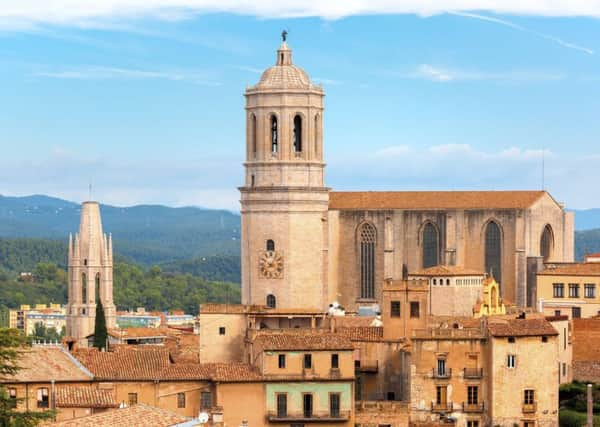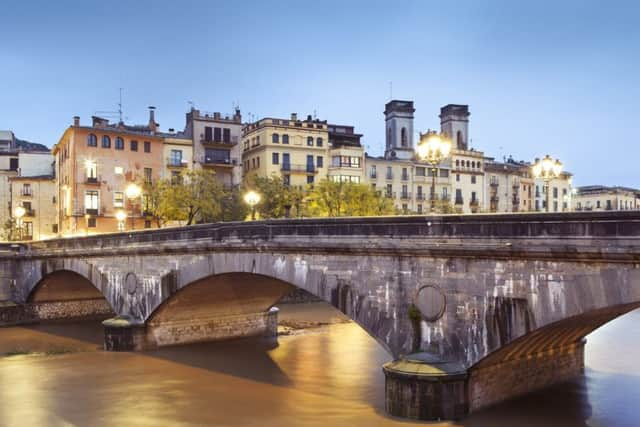Travel: Bewitched by the fantastical city of Girona


You’ve got to love a city that honours its flies. There are times they seem to be everywhere you look in the small and delicate Catalan city of Girona, some 60 miles north-east of Barcelona. Especially at this time of year. Great big friendly flies they are, some of them with broad smiley faces, most of them simple silhouettes or stylised pen and ink outlines. You see them on mugs and on T-shirts, on aprons, scarves and postcards. Plates, tiles and pencils. You even see them stamped into posh chocolates and sold in the smartest cake shops in town.
And if you really want to see them at their finest, late October’s the time of year for you as Girona gears up to celebrate Sant Narcís, its patron saint. He’s the one to thank for the flies, by the way. The legend goes that on one of the many occasions the French king turned his attention to Girona and laid siege to the city, a swarm of flies miraculously erupted from the saint’s tomb in the cathedral and drove the invading army away, forever sealing themselves in the heart of the city and turning Narcís into its patron saint and protector. What that means now is flies on every available bit of merchandising and a ten-day celebration at the end of this month that’s the perfect moment to say a final goodbye to the warmth of summer and welcome in the early dark of autumn. And it’s an ideal way to get to know this beautiful little city as it comes out to play.
Advertisement
Hide AdAdvertisement
Hide AdFounded by the Romans and fought over every century since then, Girona is mildly split in two by the narrow and gentle Onyar river. To the east is the old town, heralded by the cafés and shops of the Rambla. This is where the ritual of the passeig comes into its own, the slow evening stroll where new romances are made and the latest finery aired. The aroma of hot chestnuts and sweet potatoes is everywhere, with stands selling them in paper cones throughout the festivities. A special date is the 31st, All Saints’ Eve – our Halloween – when the locals celebrate La Castanyada, with lashings of piping hot chestnuts (“castanyes”) and muscatel wine, providing you’ve got room after the season’s other food treat of panellets, cakes made with sugar and almonds and sprinkled with pine nuts. And if you visit at any other time of year, there are still far too many sweet options and fabulous cake shops, one of the best being La Vienesa (Pujada Pont de Pedra, 1).


From the Rambla, the old town rises grandly through the ancient and narrow cobbled streets of El Call, the Jewish Quarter, a major centre of learning until the expulsion of the Jews in 1492, now home to the fascinating Museum of Jewish History (Carrer de la Força, 8). Flanked by brooding medieval buildings, the street itself was once part of the Roman Via Augusta, which led all the way to Rome. Towering over the old town is the cathedral, at the top of the highest rococo staircase in the world and boasting an unsupported nave second only in size to St Peter’s in Rome. And if it’s legends you fancy, apart from the now fly-free Sant Narcís’s tomb, look for Charlemagne’s Chair, where novice priests were forced to sit as that supposedly meant they would never marry.
I have to confess that, quite apart from the beauty of the city and the welcome of the people, it’s the legends and the steadfastly maintained traditions that have pulled me back time and time again to Girona. So much so that my first novel, about a killer using the city’s myths to tell his own story, culminates during the saint’s festivities. And to stick to the literary theme, the streets of the old town are soon going to become familiar to Game Of Thrones fans worldwide, as parts of series six have been filmed in El Call and around the cathedral, the narrow medieval lanes and imposing city walls lending themselves perfectly to an atmosphere of swords and sorcery.
The whole of the old town is embraced by the medieval defensive walls, which can be walked in their entirety, offering wonderful views over the city. On the west side of the river, though, the walls were pulled down in the 1930s in a plan to modernise that probably seemed a good idea at the time. Despite that, the modern upstart immediately across the river is a harmonious 19th-century straggle of avenues and arcaded squares, many of them taken over with flea markets and local artists’ stalls during the festivities. The centre of this part of town is Plaça Independència, a lively square full of great bars and restaurants, ranging from one of the oldest in the city, Casa Marieta (Plaça Independència, 5-6), serving excellent traditional Catalan cuisine, to the stylishly modern Dolce Vita (Plaça Independència, 11), home of very good Italian fare. Off the square are the designer shops of Carrer Santa Clara, also home to another of Girona’s imaginative food outlets. Owned by the same family as El Celler de Can Roca, named the best restaurant in the world, Rocambolesc (Carrer Santa Clara, 50) sells extraordinary combinations of ice creams and toppings, including hot buns filled with ice cream, ideal for the Sant Narcís time of year, when the weather is caught in two minds.
Going beyond Plaça Independència takes you to the Parc de la Devesa, striking for its implausibly high plane trees reaching for the sun. For most of the year, the park is quiet, used mainly for the lively weekly market, but during the Sant Narcís festivities it’s taken over by a funfair, a raucous celebration of lights and noise, with stalls dotted among the trees and rides running scarily close to the top branches of the plane trees. Like the rest of Girona, it’s buzzing, but luckily for visitors, the city and its streets, parks and squares are all that you’ll find buzzing. The flies are just there for show.
City Of Good Death by Chris Lloyd is published by Canelo (ebook, £2.99)
FACT FILE
• Festival of Sant Narcís aka Fires de Girona, 24 October-2 November. The annual fiesta celebrates Sant Narcís, with fireworks and processions of “giants” – wood and waxwork dummies of kings and queens. There are also street concerts and children’s activities. (00 34 972 010 001; en.costabrava.org)
• Ryanair flies from London airports to Girona, starting from £20 one way (www.ryanair.com). Direct flights from Scotland end 3 November, resuming in March 2016.